Merry Christmas from FrugalFilmMakers.com
See my Flickr pictures for the latest shots taken with the GH3.

See my Flickr pictures for the latest shots taken with the GH3.
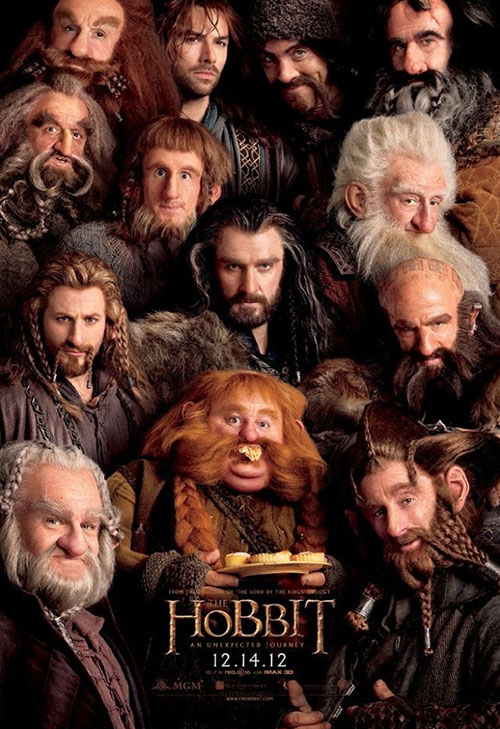
This is a very important essay by Vincent Laforet who started the HDSLR revolution with the short film: “Reverie.”
“Many of you are likely aware that when a motion picture camera pans or moves too quickly – it can be painful for the audience’s eyes. In fact on a 30-50 foot screen it can be impossible to see a sharp image or for the audience to lock onto something with their eyes if the movement is too fast. This is something filmmakers and experienced DPs keep a very close eye on – in fact there are tables that show how fast a camera can move given any given lens before this blur happens.
Therefore Peter Jackson decided to shoot the Hobbit in48 fps to try to counter this effect, and to render a more realistic or what he deems “immersive” 3D experience if you will.
And he has indeed accomplished that – but in doing so, he’s killed a lot of the magic of what makes a film entrance an audience if you will, at least in my opinion. I did find myself become more “immersed” in the 3 dimensional environment and all of these details – but to the detriment of the film and the narrative itself.”
Click here for the entire essay.

Christmas came a little early. The Panasonic GH3arrived recently and I have been testing it. One of the main reasons I wanted to get this camera is because of the improved audio. That is the subject of this review. Before I get to that, a few comements.
Following the GH2, the new GH3is almost a revolutionary camera. That is a camera that was designed for both stills and video equally. After Panasonic showed the GH3 at Photokina, I knew I had to buy one.
The GH3 adds features that all photographers will like. I am impressed with the weather sealing and robust construction with magnesium as the choice of body material. There is a new 16.05-megapixel digital Live MOS sensor with reportedly better low noise performance and dynamic range. The new Venus engine is used with four cpu's for improved performance. There are 3 control dials. One wheel on the front next to the shutter button. One wheel in the back top right hand corner and a central control dial on the back around the four way controller.
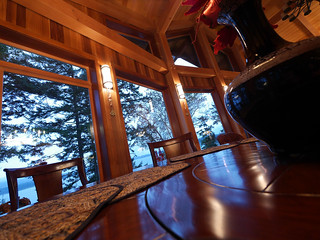 Panasonic has added an electronic shutter function on the front and rear curtains for vibration-free operation and I can say that I love it. A big benefit for being quiet at events. The is a new battery as well. It has a new viewfinder and back LCD have been improved with OLED displays. Another nice new feature is WiFi. Panasonic has be released both IOS and Android apps for control, viewing and downloading. I miss the USB control on my old Canon 60D and am happy Panasonic close to include WiFi. I am already using it.
Panasonic has added an electronic shutter function on the front and rear curtains for vibration-free operation and I can say that I love it. A big benefit for being quiet at events. The is a new battery as well. It has a new viewfinder and back LCD have been improved with OLED displays. Another nice new feature is WiFi. Panasonic has be released both IOS and Android apps for control, viewing and downloading. I miss the USB control on my old Canon 60D and am happy Panasonic close to include WiFi. I am already using it.
The video portion of the camera is where the GH3 shines will be the subject of a later review. The video picture quality of the GH3 is as good as GH2 (which is a good thing) with none of the typical HDSLR problems of moiré and false color and lack of resolution. The camera has a newly designed low-pass filter so sharpness should not be an issue like the Canon's.
 First of all, I don't like double system audio and like to record in the camera audio. Why do something twice if you don't have too. With Linear PCM recording, Panasonic smartly added better quality audio. The camera now has the standard 3.5mm audio jack we are used to on most cameras that don't feature XLR. They also added a 3.5mm headphone jack as well for audio monitoring and it sounds wonderful. At last, Audio Monitoring. That is adjustable in the menus. There is also better control over the audio level in the menus too. With 14 levels of adjustment there is plenty of control. I prefer to keep the levels in the camera low so I don't use the noisy preamps. I use a JuicedLink DT 454 Preamp to give good levels with XLR microphones.
First of all, I don't like double system audio and like to record in the camera audio. Why do something twice if you don't have too. With Linear PCM recording, Panasonic smartly added better quality audio. The camera now has the standard 3.5mm audio jack we are used to on most cameras that don't feature XLR. They also added a 3.5mm headphone jack as well for audio monitoring and it sounds wonderful. At last, Audio Monitoring. That is adjustable in the menus. There is also better control over the audio level in the menus too. With 14 levels of adjustment there is plenty of control. I prefer to keep the levels in the camera low so I don't use the noisy preamps. I use a JuicedLink DT 454 Preamp to give good levels with XLR microphones.
So far I am very happy with the new camera and have taken some sample pictures. They cam be found at Flikr.
Watch the video below to see and hear the quality of the audio with the tests I did.
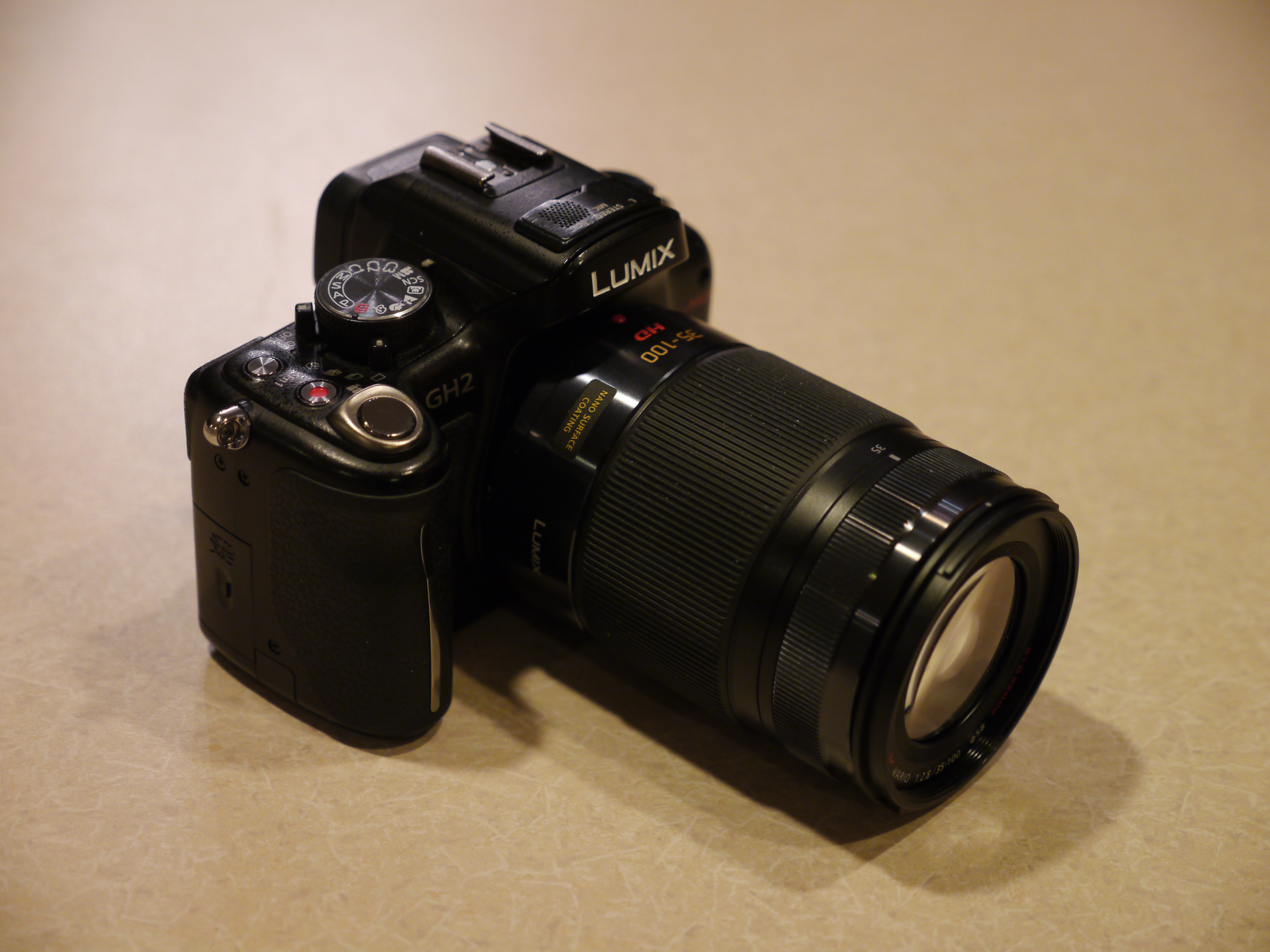
Yes, there is nirvana, twice. If you have following my site you would know that I have been very excited about two new lenses from Panasonic. The other one of them has been introduced and it is just now becoming available in the US. I had already purchased the the first one, the Panasonic Lumix X Vario 12-35mm F2.8 ASPH Power O.I.S. it has lived on my GH2 ever since. After seeing the new lens at the Kenmore Camera show last month, I waited to till it was available. Then out came my debit card and over a thousand and a half dollars later, I ordered it. Two days later it arrived but I was traveling for Thanksgiving so I had to wait till I got home! I am not disappointed! I have the brand spanking new wonder lens: the Panasonic Lumix G X Vario 35-100mm F2.8 ASPH Power O.I.S. It has not been left off of my other GH2. That is one of the advantages of having two GH2's.
The New View
 This is the most expensive lens I have bought including when I had Canon L lenses and my Lumix G X 12-35mm f2.8. I did not buy the Canon L EF 70-200 f2.8 because it was too expensive, large and heavy. I bought the Canon L EF 70-200 f4 IS because it was very sharp, smaller and lighter. It was used on my Canon 60D a lot. A truly wonderful lens. Like both of the Canon's, this lens has weather sealing and is made to a higher standard than their regular lenses. Panasonic choose to brand this lens as well with their upscale X designation. Unlike the Canons, this lens is much smaller and lighter. It will become one of the lenses that I always carry with me.
This is the most expensive lens I have bought including when I had Canon L lenses and my Lumix G X 12-35mm f2.8. I did not buy the Canon L EF 70-200 f2.8 because it was too expensive, large and heavy. I bought the Canon L EF 70-200 f4 IS because it was very sharp, smaller and lighter. It was used on my Canon 60D a lot. A truly wonderful lens. Like both of the Canon's, this lens has weather sealing and is made to a higher standard than their regular lenses. Panasonic choose to brand this lens as well with their upscale X designation. Unlike the Canons, this lens is much smaller and lighter. It will become one of the lenses that I always carry with me.
This lens is the ideal interview lens for MicroFourThirds. The 12-35mm is a little short for interviews because the camera has to be closer than some people are comfortable. Being a video guy who likes to take stills, this lens fills a big gap for me. I have wanted a F2.8, O.I.S. tele lens for shooting video. O.I.S. really combats the shakes and helps eliminate rolling shutter. Being a zoom is a plus, or should I say variable prime.
Boy This Is Small
What we have here is a small, lightweight, fast, ruggedized O.I.S. telephoto zoom lens. On the my GH2 the lens seems to belong there but at the same time it seems small for a tele zoom. It is in diameter about the same as my Lumix 14-140 variable aperture zoom. The weight is about the same too. It fits nicely into my hands and the zoom does not extend when it is zoomed to 100mm with that magical F2.8 aperture. The main barrel seems like metal. The zoom feels very smooth. Smooth enough to shoot during movies. The lens's balance is very good.
What can we say, this lens is very sharp. Sharp in the center and sharp in the corners. There is very little chromatic aberration in the corners of the lens. Also there is the ability to separate your subject from the background because of the fast F2.8 aperture. On the tele end this is very easy.
Fast Focus
Autofocus is fast and silent on all my cameras. The manual focus ring feels like metal and is very responsive in manual mode. It takes some turning to change focus so I feel rack focusing while be easy. It is not fast like the cheaper lenses. Also if you zoom in and focus the lens seems to keep the focus as you zoom out.
One Stable Lens
With the GH2 I leave the O.I.S. on as this one of the reasons I bought the lens. It is Panasonic's new Power O.I.S. which is very effective while hand holding the camera. I like that Panasonic has put the O.I.S. switch on the barrel of the lens as I turn it on and off quite often. I turn it off on the EM-5 as that camera has internal image stabilization which is quit effective. They fight each other if both are turned on and it is easier to turn off the lens than going into the menus and turning off the camera's. The O.I.S. is needed more on this lens than it's shorter sibling.
There is a clicking sound from the aperture even at the full F2.8 on the GH2 when not shooting movies but it goes away when shooting. What a relief. On the EM-5 there very little sound from the aperture. On my 14-140 the aperture changes while zooming and the video see variances of light as the zoom takes pace even when the lens is stopped down a aperture stop that is smaller than the smallest aperture on the telephoto side. This is why I wanted a constant aperture lens. If there is any change it is slight and is nothing to worry about.
Worth The Wait
I have to say it has been worth the wait. This lens will get a lot of use by me. Panasonic pulled out all the stops on this one as well. Is as good as we thought it might be? Yes! What more could we ask for? Some are saying the price is to high, but this is a “luxury” lens like the one from the other guys. Their's is much bigger, heavier and expensive. What we get for this expense is a lens that bring MicroFourThirds into the big leagues with it professionalism with a fast tele zoom.
When Panasonic showed the prototype of this lens they also showed a 12-35mm F2.8. O.I.S. This new wonder tele zoom was introduced at Photokina this year in Germany.
I have posted stills taken with the lens on flickr.
Here is a video review of the lens actually on a camera shooting video on my GH2.
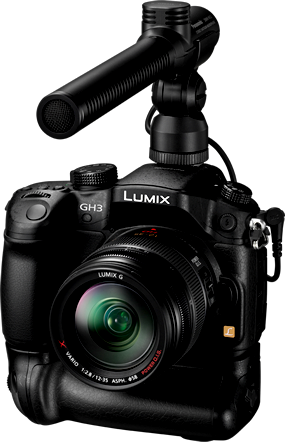
A nice new video shot with a preproduction version of the GH3.
A day in Montmartre – [Panasonic Lumix GH3] from emeric on Vimeo.
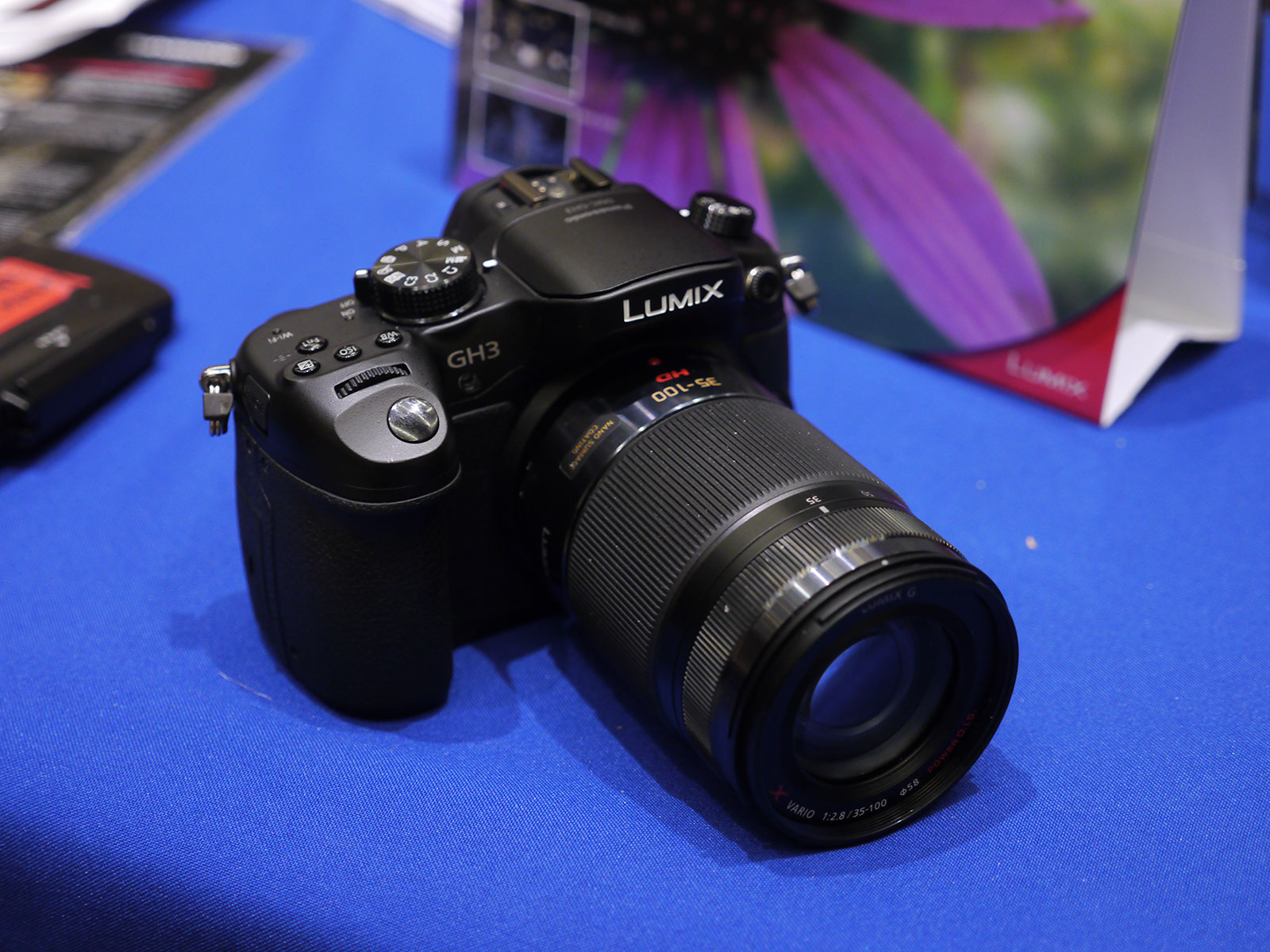
Recently I went to the Digital Photo Expo sponsored by Kenmore Camera near Seattle. There, at the Panasonic booth I saw the new Lumix GH3. The new Lumix G X 35-100mm f/2.8 lens was there also. Both the lens and the camera were recently introduced at Photokina in September and I have been wanting to see them. I am very impressed with both of these new items from Panasonic.
The GH3 is an impressive camera. It is larger than the GH2, but not that much larger and it fits much better in my hand because of the larger grip. Now I have a place for my bottom finger. I like the new top buttons on the grip for ISO, White Balance and Exposure Compensation. Most of the controls were in a very logical place and were very easy to use. With either the 12 – 35 or 35 – 100 lens the camera felt very well balanced and lightweight. The new menu system has a lot more options but is laid out better and I think more logical. A GH2 owner should have no problem navigating the menus.
That new swivel OLED LCD was large and bright and look very good to the eye. Like the GH2, it is very flexible in it's use. I am glad to see Panasonic stay with a winning design. I did like the new OLED view finder. It also is bright and sharp just like the Swivel LCD on the back. I was amazed that the viewfinder's diopter correction was adjustable enough so I could actually use the viewfinder without my glasses. No other camera has been able to do that. For me, one of the downfalls of the new electronic viewfinder is that in still photography mode, the image seems a little smaller to the eye. In movie mode the image gets wider so it's about the same size as with the viewfinder on that GH2. The on screen displays in the viewfinder is more complete then the GH too. Among the new things you can display is timecode.
The camera I tried was one of the models shown at Photokina, so it was a PAL camera not an NTSC camera so it did not have 60fps or 30fps. So I tried it at 50 frames per second. While I was shooting a movie, the camera allowed me to halfway push the silver shutter button to refocus from one area to another just like on the GH2. Thank you Panasonic. I use this a lot. There are 19 steps of audio level and there are still audio meters in the viewfinder. I did not have a chance to try the headphone jack.
I was able to try my Micover I use on my GH2 to cut wind noise and it will not work on the GH3. The stereo mics are behind the flash and the Micover does not reach. I will have to use something different.
Other than the slightly smaller view in the viewfinder, I really like using it as a still camera as well. I absolutely loved the silent mode for still shooting. It uses the electronic shutter to take pictures. No mechanical shutter sound at all and you could totally silence the camera so you could not hear me taking pictures. It was just like a video camera, no sound. I have found the camera quieter than my Olympus E-M5.
The new Lumix G X 35-100 f/2.8 Power O.I.S. is very small and light weight. The focus is fast. The zoom barrel does not move because of the internal zooming like Canon's 70-200. A very nice lens. Did I say small. I will being doing a repot on that lens when it arrives.
While at the show I was able to shoot stills and video and those will be included in my video report. (edited with FCPX 10.0.6)
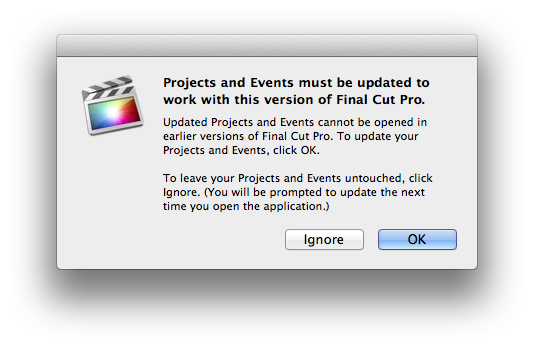
Apple has released a new version of Final Cut Pro X. 10.0.6 adds many new features. I have upgraded already and will report back on FCPX in a future post.
So let's take a quick look at the list of new features.
Apple have released a Knowledge Base article and it should be essential reading before anybody upgrades to 10.0.6. The article recommends backing up not only projects and events, but also the app as well.
I read a rather silly article over at PetaPixel: Photog Denied Park Permit Because His Mirrorless Camera Lacks a Mirror. Having gone mirrorless since last December with the GH2, I took offense at this nitwit in charge at a Navajo Tribal Park, Antelope Canyon. I got miffed when I was not allowed to take my Olympus E-3 with a old Tamron 300 f/2.8 into so called public stadium called SafeCo field. It is a private team that plays there so I guess they have the right to rule who shoots there. They told me I looked to professional with my big lens. I guess the Navajo's got it in reverse.
 The photographer, Gordon Laing, the founder of Cameralabs, found out the hard way that you should not bring a mirrorless camera there if you want to be treated as a professional. He was using a Panasonic GX-1. Only professionals are allowed to go and shoot unescorted. Never mind according to wikipedia.org, “Antelope Canyon is the most-visited and most-photographed slot canyon in the American Southwest.” He said when he had been there before he had bigger camera with mirror. To see if he was a professional the goon asked hime if his camera had a mirror.
The photographer, Gordon Laing, the founder of Cameralabs, found out the hard way that you should not bring a mirrorless camera there if you want to be treated as a professional. He was using a Panasonic GX-1. Only professionals are allowed to go and shoot unescorted. Never mind according to wikipedia.org, “Antelope Canyon is the most-visited and most-photographed slot canyon in the American Southwest.” He said when he had been there before he had bigger camera with mirror. To see if he was a professional the goon asked hime if his camera had a mirror.
I guess most places don't realize that our mirrorless cameras are just as good as our mirrored brethren. May be this is a good thing for must situations as in stealth. I hate permits anyway because I take pictures or video anyways. (with or without permission)
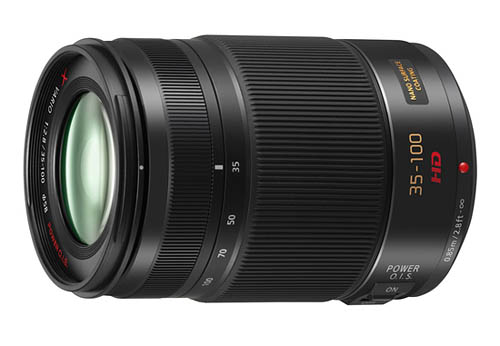
Here is a photographic First Impression View of the new PANASONIC LUMIX G X 35-100mm F2.8 Power O.I.S. over at Popco.
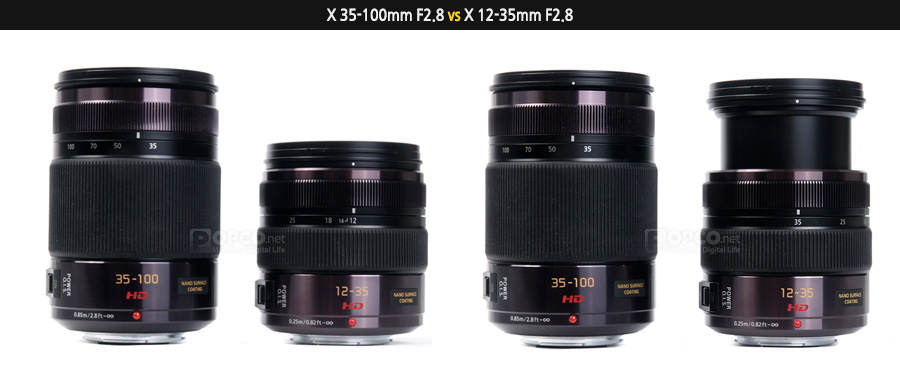
LUMIX G X 35-100mm f/2.8 Power O.I.S.
What I gather from these photos, like my old Canon EF 70-200 f/4 IS, the zooming is internal. The barrel does not move like my Lumix G X 12-35mm f/2.8. This is wonderful for video shooters who want to add accessories like a matte box.
The new GH3 is almost a revolutionary camera, if it was not for the GH2. The GH2 was the first hybrid camera. A camera that was designed for both stills and video equally. The GH2 set new standards for stills and video in one box. It does not compromise at a price that won't break the bank. The Canon still cameras are compromised for video. The Nikon still cameras are compromised for video. The new Sony A99 looks very good but it is in a much more expensive and larger camera. The sensor is a full 35mm so it does not match the aesthetics 35mm motion pictures. We will have to see how it performs. Both the Sony NEX cameras and Olympus OM-D have some problems as well.
This article is based on what I have read online after the introduction by Panasonic of the GH3 at Photokina. The GH3 adds features that all photographers will like. To begin with it has weather sealed robust construction with magnesium as the choice of body material. There is a new 16.05-megapixel digital Live MOS sensor with reportedly better low noise performance and dynamic range. As rumored, a new Venus engine is being used with four cpu's for improved performance. Panasonic has added an electronic shutter function on the front and rear curtains for vibration-free operation. A big benefit for low shutter speeds. The battery has been enlarged for longer operation.
Both the viewfinder and back LCD have been improved with OLED displays. The pixel count has been increased for clearer viewing. 1.7 million pixels on the EVF and 614k on the 3 inch rear screen. The camera readout has been increased to 240 frames per second for faster focusing and less lag in the viewfinder.
Another nice new feature is WiFi. Panasonic will be releasing both IOS and Android apps for control, viewing and downloading. I miss the USB control on my old Canon 60D.
But as many have said, the video portion of the camera is where the GH3 shines and Panasonic has addressed the needs of the videographer very well. The GH3 ads much higher bit rates (up to 80mbs ALL-I) than its AVCHD brethren. It has higher frame rates, audio monitoring and control all in a weather sealed body unlike the GH2. This has the benefit of recording every frame like the Canon 5D Mark III, costing $3000 and with better sharpness too. The 5D has less than 720p resolution because of its line dropping. The video picture quality of the GH2 is as good as cameras costing 10 times as much with none of the typical HDSLR problems of moiré and false color and lack of resolution. The camera has a newly designed low-pass filter so sharpness should not be an issue like the Canon's. If Panasonic keeps the good sharpness, they will have a winner.
The GH3 catches up with other cameras that offer 1080 60p recording at a maximum bit rate of 50Mbps. Canon does not ofter this in any of their cameras including the expensive C (Cinema) series. This higher frame rate will help those who like slow motion or those who want less judder in movement. Some like 720 60p for its clear motion and this new camera will give this at a higher resolution. I have read that Panasonic has kept the telephoto crop mode of the GH2 but we will have to wait to see.
Besides AVCHD, Panasonic now offers MOV and MP4 format for recoding video. The 80Mbps ALL-I format is only available in the MOV wrapped which is a lot easier to work with AVCHD and its file structure. With ALL-I format records every frame so there is no motion interpolation between frames. Offering All-I encoding means the GH3 has caught up with the Hacked GH2. Also available is the IPB (interpolated) format which has had its nitrate increased from 24Mbps to 50Mbps, again like the GH2 Hack). The maximum bit rate for AVCHD is 28Mbps at 1080 60p.
Another area the GH3 improves is audio with Linear PCM recording. Panasonic smartly added the standard audio jack 3.5mm we are used to on most cameras that don't feature XLR. They also added a 3.5mm headphone jack as well for audio monitoring. Reportedly there is also better control over the audio. I don't like double system audio and record in the camera.
Speaking of control there are 3 control dials. One wheel on the front next to the shutter button. One wheel in the back top right hand corner and a central control dial on the back around the four way controller.
By far the most controversial aspect of the GH3, is it's size. Panasonic has said they wanted to build a camera aimed at more serious users and they feel they had to make the camera bigger with more room for controls. The GH3 is the largest m43rds camera to date. It is about the same size of a Canon T4i which is a bit bigger than the GH2. A lot of people have flocked to the m43rds format because it is small. The GH2 is small, so small it does not fit my hands. My bottom finger does not know what to do. I did not mind the size of my 60D and the GH3 is smaller than it. I think it will fit my hands better. it is not much heavier either: 19.40 oz vs. 14 oz for the GH2. The 60D is 26.6 oz. When you include all the changes to the GH3, increased size and weight is not much to pay for.
This new camera only validates how good the GH2 is. I plan to keep my GH2 for a long time. If I want small and inconspicuous, I will grab the GH2. If I want more capable then I would have to choose. But actually the more important news out of PhotoKina was the launch of the Lumix G X 35-100 f/2.8 O.I.S. We will cover that at a later date when I have one.
By the way the GH2 is a great stills camera as well and the GH3 will be as well. I love seeing the exposure, focus, white balance and depth of field in the viewfinder. Also not having to take my eye away from the viewfinder to see playback is absolutely the best. Not even my excellent Olympus E-M5 does this.
Thank you Panasonic for listening.